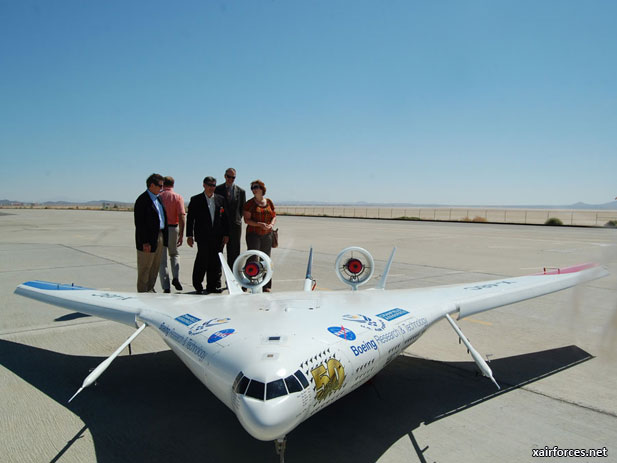
Mixed Success for Boeing X-planes at Edwards

The X-48C is flying under a NASA contract to investigate the aerodynamic characteristics and efficiencies of the BWB concept.
Boeing and NASA believe that a full-scale BWB designed for airlift and aerial refueling could offer significantly lower fuel consumption and noise levels than conventional designs. The X-48C is a modified version of the X-48B, another unmanned subscale aircraft, which flew 92 times at the NASA Dryden Flight Research Center between 2007 and 2010. The X-48C is powered by two 89-pound-thrust turbojets instead of the three 50-pound-thrust engines on the -B; and wingtip winglets have been relocated inboard next to the engines on the -C, effectively turning them into twin tails. The aft deck on the -C was extended about two feet at the rear. The UK’s Cranfield Aerospace built the model to Boeing’s design specifications.
The third flight of an X-51A was terminated when a faulty control fin prevented the firing of its Pratt & Whitney Rocketdyne scramjet, according to the U.S. Air Force Research Laboratory (AFRL), which is funding the program. The 25-foot-long unmanned vehicle did launch successfully from the B-52, which flew from Edwards to the test area off the California coast. The test vehicle’s rocket booster also fired as planned. But fifteen seconds after it separated, control of the X-51A was lost.
After a successful test flight of the first X-51A in May 2010 to 70,000 feet and Mach 5, the second X-51A was also lost in June last year after an inlet unstart. Boeing has built four X-51As; the AFRL has not yet decided whether to flight test the last one. The program has already cost $250 million, according to a briefing last June by Joe Vogel, Boeing’s director of hypersonics. But, he continued, “This is a history-making project–the Rosetta Stone of future space access.”
Source: By Chris Pocock - AINONLINE News - 17 August 2012
Photo: The X-48C blended wing body research vehicle on the ramp at NASA’s Dryden Flight Research Center at Edwards AFB, a few weeks before its first flight. (Photo by Chris Pocock)
(17.08.2012)
|